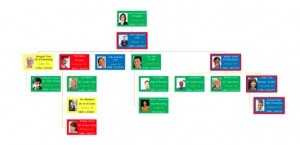By: Gary Cohen
While it’s important to have one basic org chart—to be posted on the intranet, hung up and shared at meetings, constantly maintained by HR, and published with every new employee hire—you can learn a lot from more sophisticated org charts. Org charts can be arranged by function, process, product, market, customer, geographic, matrix, or a combination approach. These charts tell a more interesting and complex story. They can be useful for you, your advisors/coaches, and board members in discussing and reviewing the readiness of your organization.
Simple hierarchical org charts are blunt tools. They suggest that knowledge is greater or more accurate at the top, and that decision-making is done by a select few. These charts tell you where employees currently are, but not where they’ve been or where they’re going next.
Your org chart can tell a more informed story by adding compensation information, date hired, communication/leadership style, potential successors, and the development plan. An org chart of this nature can’t and shouldn’t be shared with all audiences, of course. Adding this information increases the complexity of the org chart, though, and may help you see the web of connections and future implications. Seeing these connections and implications may remind you of the need to be an active learner as a leader (not a finished product).
“The perceived need to learn something new is inversely proportional to the rank of a manager. Those at the top feel obliged to pretend to omniscience, and therefore refuse to learn anything new even if the cost of doing so is success.” – Russell Ackoff
Turn your org chart into an evaluative and effective story-telling tool by adding these five things:
-
Compensation
Adding compensation to the org chart will help you discover egregious discrepancies, predict salary inflation consequences, and do back-of-a-napkin calculations:
- Egregious Discrepancies: You can see quickly if there are any egregious discrepancies based on age, gender, race, or role within the organization, especially if you have a smaller organization without a highly formalized process in HR.
- Salary Inflation Consequences: When you are considering increasing compensation for a particular employee, you can quickly see if it may lead to salary inflation throughout the organization, especially if you have a smaller organization without a highly formalized process in HR.
- Back-of-a-Napkin Calculations: If you are in need of right-sizing or downsizing, you will be able to do calculations much faster in your head to understand implications of each move.
2. Date Hired
Adding the date employees were hired will help you get a sense of their institutional knowledge, development progress, and value to the organization:
- Institutional Knowledge Indicator: Some people feel their institutional knowledge and experience are undervalued. Others may not be up to speed on highly impactful/polarizing moments in the organization’s history that preceded their hires. By having the hire date on the org chart, you are able to better understand employees’ level of institutional knowledge (and compare what they know vs. what they should know by now).
- Development Progress & Complicating Factors: In general, adding “date hired” will give you a better sense of employees’ developmental progress. Be sure to take into account if the employee has had to switch roles multiple times, though, or make huge changes in order to accommodate different managers’ expectations. These situations can stifle typical developmental-progress trajectories.
- Value: Looking at employees’ hire dates and compensation side by side, you may draw some insight into how they are valued by the organization.
3. Communication/Leadership Style
Including a social indicator on an org chart can be a great reminder that we are not all wired the same and using that wiring to enhance cognitive diversity can improve organizational performance.
Companies use different assessments to determine their employees’ communication and leadership styles, so that they can assemble groups that mesh well and are balanced in terms of skills/approaches. While popular assessments like Myers Briggs, Strength Finders, Caliper, Predictive Index, and Disc have their merits, these models typically suggest a fixed mindset. At CO2, we developed the PEAK model, which measures a person’s ability to trust others and their willingness to learn, adapt, ask, and test their own beliefs. With the PEAK model, leaders can learn just how much they are inclined to seek Perspectives (Innovators), Evaluate information at hand (Judges), take Action (Directors), and increase Knowledge (Professors). Their PEAK number suggests not only how they typically make decisions, but also how they communicate with others.
Great leaders know when to take action, when to seek other perspectives and increase knowledge, and when it’s time to evaluate what they’ve learned. While they likely have a dominant style, these leaders can and do change for the better when they seek balance in their own questions/approaches, not just on their teams. They use cognitive diversity to make well-considered decisions after examining all their options and analyzing potential repercussions.
Knowing the communication/leadership style of your coworkers can help you better utilize their skills and contextualize their input.
4. Potential Successors
The first job you have as a leader is to ensure the sustainability of your organization. Sustainability is built upon stability, and stability comes from knowing where you’ve been, where you are now, and where you’re going. As a result, you and all the other leaders in your organization should identify a successor as soon as possible, if you haven’t already. Your organization will better know where it’s going once successors have been lined up.
Organizations are generally aware of the importance of succession plans, but for some reason tend to limit that planning to the very top positions: CEO, president, and the like. That’s really short-sighted. Every leader, manager, and supervisor should have a successor ready for their position—a specific person identified and capable of filling in if that role suddenly becomes vacant (promoted, fired, retired, etc.) Here’s why: With succession planning, managers don’t need to hold onto key employees—sabotaging the pace of these employees’ upward trajectory. With a capable replacement on hand, managers can also be more candid with reports because they do not feel held hostage by employees who are marginally performing.
While it makes sense for direct reports to be succession candidates, don’t feel obligated to go this route. Notice in the example I’ve provided below (which is organized by function) how the CEO has the COO promotion ready, and the COO has two possible candidates (both the CFO and the VP of Operations) and has chosen the VP of Operations. The best succession candidate may not be directly in line vertically (due to shuffling of positions or other reasons), and it may behoove the organization to have more than one succession candidate prepared in a volatile climate or simply for insurance purposes.
5.Development Plan
As I mentioned earlier, it’s helpful to know not only where employees are (and when they were hired), but where they might be going next.
For the sake of efficiency, you can use color-coding to indicate employees’ communication/leadership style or their development plan. In the example below, I’ve used the following color code to indicate their development plan:
- Blue – Upwardly promotable
- Green – Excellent in role, laterally ready for job change, has development plan to move to blue
- Yellow – Can do this role and has a development plan to move them to green
- Red – The person is on a performance improvement plan
Uses of Org Charts :
Meetings
Org charts can be both informative and handy—especially if you use color-coding effectively and include headshots/photos (so that you and others can be more clear on who you’re discussing). In meetings, you can jot notes on the chart to remember what was said or what needs to be communicated to whom. As I mentioned earlier, be aware of audience and context, though, in terms of what org charts you share with others.
Future Planning
When your organization is scaling, it is helpful to plan out multiple org charts over time. Start with a properly updated current chart and put in roles that are not yet filled. Then based on your growth rate, decide the timeline that will be most helpful. For a company growing 30% a year, you may want to have three org charts: one current, another org chart for one year from now, and one for two years from now. Doing so will help you visualize who you will need to hire today and also plan for future hires. In the process, it will clarify your development strategies for current employees. These employees will be grateful for the opportunity to see this vision of the future. When organizations are growing, they often have a pace that is exhausting for everyone. Many of the folks have hope of future possibilities and promotions. By giving them a visible demonstration of what you believe will transpire, you are giving them reason to hang on even during the tough times for the benefit of their career.
Note: In the example below I haven’t fully blown out the chart. I only went as far as needed to demonstrate the value and the nomenclature on the chart.

What story does your org chart tell? And how might you use org charts to improve or evaluate your organization’s readiness?
By: Gary Cohen

